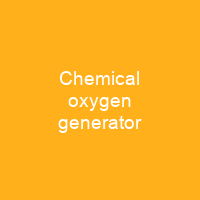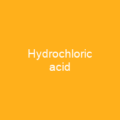What Exactly Is a Chemical Oxygen Generator?
A chemical oxygen generator is like a mini factory inside your airplane or submarine, ready to produce life-saving oxygen when you need it most. Imagine having a device that can turn simple chemicals into breathable air – sounds almost magical, right? This technology has been crucial in various high-stakes environments where the air quality can suddenly become hazardous.
How Does It Work?
The process is akin to setting off a small firework show. When activated, these generators ignite a chemical reaction that releases oxygen. The oxidizers used are usually superoxide or chlorate compounds, which when heated up, break down and release pure oxygen. This reaction can be quite intense, producing heat as high as 260°C (500°F), making it essential to handle with care.
Types of Chemical Oxygen Generators
Commercial airliners, for instance, rely on these generators to provide emergency oxygen. When the cabin pressure drops suddenly, like during a decompression event, these devices kick in, ensuring passengers have enough breathable air until they can land safely.
The Sodium Chlorate and Barium Peroxide Mix
These generators are packed with ingredients that sound more like a chemistry experiment than a life-saving device. The oxidizer core often contains sodium chlorate, barium peroxide, and potassium perchlorate. When activated, these chemicals react to produce oxygen for 12-22 minutes, enough time to get everyone on the plane or submarine to safety.
Accidental Activations: A Cautionary Tale
The history of chemical oxygen generators is dotted with cautionary tales. Accidents like those seen in ValuJet Airlines Flight 592 and an ATA DC-10 in 1986 remind us that these devices, while life-saving, can also be dangerous if mishandled or improperly shipped.
The Oxygen Candle: A Smoldering Solution
An oxygen candle, on the other hand, is a cylindrical device that contains sodium chlorate and iron powder. This mixture smolders at 600°C (1,100°F) to produce oxygen. The key here is maintaining the right temperature; otherwise, it could just sit there like a dormant volcano, waiting for the perfect conditions to erupt.
Key Reactions
The reactions involved are fascinating and complex. For instance:
- 2 NaClO3 → 2 NaCl + 3 O2
- LiClO4 → LiCl + 2 O2
The explosion of an oxygen candle on HMS Tireless in the Royal Navy serves as a stark reminder of the potential dangers. It’s a powerful lesson that even seemingly harmless chemicals can be deadly when not handled properly.
Other Applications and Innovations
Lithium perchlorate is another compound used in some spacecraft, where it releases 60% of its weight as oxygen at 400°C (750°F). This makes it a valuable resource for space missions where every ounce counts.
Meanwhile, pressure swing adsorption (PSA) oxygen generators use molecular sieves to separate gases and produce an oxygen-enriched gas. These are used in various applications, from medical settings to industrial processes, ensuring that the air we breathe is always clean and pure.
The Future of Chemical Oxygen Generators
As technology advances, so too do our methods for generating emergency oxygen. While chemical generators remain a vital part of many safety protocols, innovations like PSA systems offer cleaner and more reliable alternatives. The future may see a blend of both – the old and the new – working together to keep us safe in unpredictable situations.
In conclusion, chemical oxygen generators are not just about survival; they’re about preparedness and resilience. Whether you’re flying high or diving deep, knowing that these devices can provide life-saving oxygen is reassuring. As we continue to explore new frontiers both on Earth and beyond, the importance of reliable emergency oxygen systems will only grow.
You want to know more about Chemical oxygen generator?
This page is based on the article Chemical oxygen generator published in Wikipedia (retrieved on November 29, 2024) and was automatically summarized using artificial intelligence.








